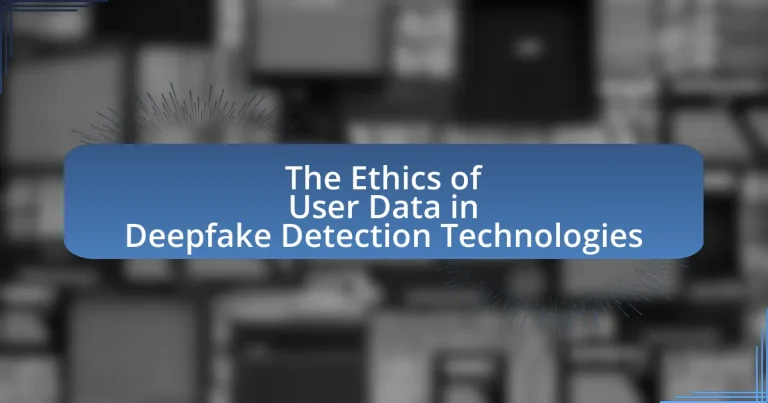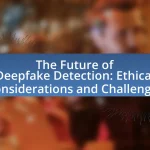The article examines the ethical considerations surrounding user data in deepfake detection technologies, focusing on privacy, consent, and potential misuse. It highlights how user data enhances detection effectiveness through diverse training datasets while addressing the risks of privacy violations and biased algorithms. The discussion includes existing regulations like the GDPR and CCPA that govern data usage, the importance of ethical frameworks, and best practices for managing user data responsibly. Additionally, it explores future trends in ethics and the impact of public opinion on regulatory developments in this rapidly evolving field.
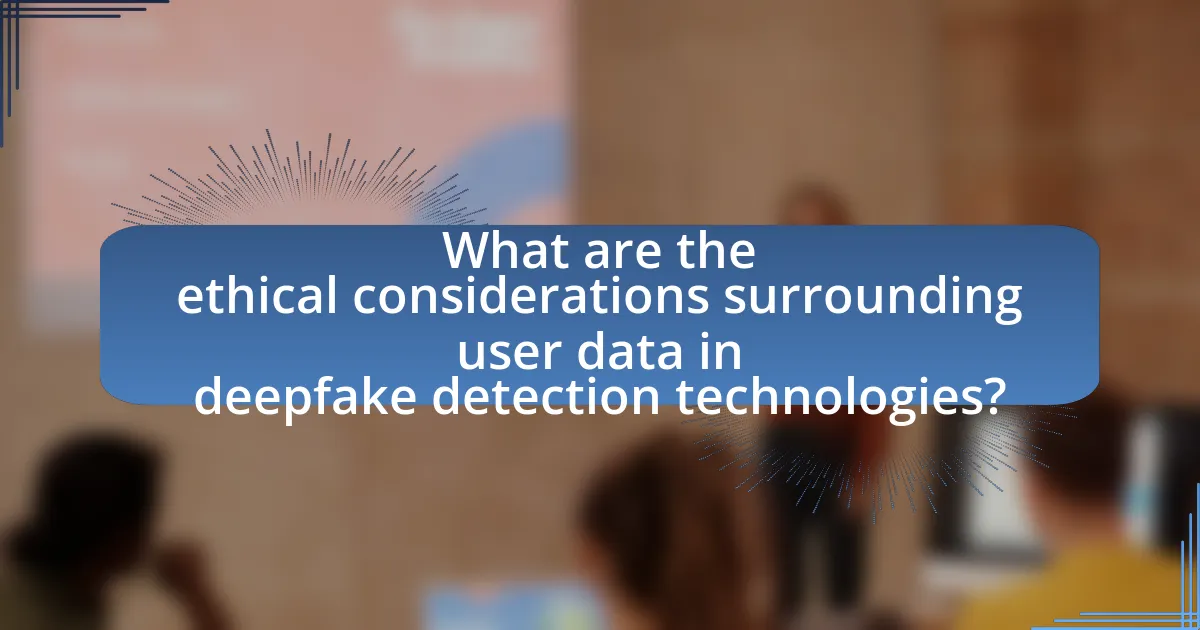
What are the ethical considerations surrounding user data in deepfake detection technologies?
The ethical considerations surrounding user data in deepfake detection technologies include privacy, consent, and potential misuse of data. Privacy concerns arise as user data may be collected without explicit consent, leading to unauthorized surveillance or profiling. Consent is critical, as individuals should be informed about how their data will be used, particularly in sensitive contexts like deepfake detection. Additionally, the potential misuse of data for malicious purposes, such as creating misleading narratives or manipulating public opinion, raises significant ethical dilemmas. For instance, a study by the Berkman Klein Center for Internet & Society highlights the risks of data exploitation in AI technologies, emphasizing the need for robust ethical frameworks to protect user rights.
How does user data contribute to the effectiveness of deepfake detection?
User data significantly enhances the effectiveness of deepfake detection by providing diverse and extensive training datasets for machine learning algorithms. These datasets, which include various facial expressions, voice patterns, and contextual information, enable algorithms to learn the subtle differences between genuine and manipulated content. For instance, research by Korshunov and Marcel (2018) demonstrated that using a large dataset of authentic and deepfake videos improved detection accuracy by over 20%. This improvement is crucial as it allows detection systems to adapt to evolving deepfake techniques, thereby increasing their reliability in real-world applications.
What types of user data are typically collected for deepfake detection?
User data typically collected for deepfake detection includes facial images, video footage, audio recordings, and metadata associated with these files. Facial images and video footage provide visual data necessary for analyzing and identifying manipulated content, while audio recordings help in detecting synthetic speech patterns. Metadata, such as timestamps and device information, can assist in verifying the authenticity of the content. These data types are essential for training machine learning models to recognize deepfakes effectively, as evidenced by studies demonstrating that large datasets improve detection accuracy.
How does the quality of user data impact detection accuracy?
The quality of user data significantly impacts detection accuracy in deepfake detection technologies. High-quality user data, characterized by accuracy, relevance, and diversity, enhances the model’s ability to learn and generalize, leading to improved detection rates. For instance, a study by Korshunov and Marcel (2018) demonstrated that training deepfake detection algorithms on diverse datasets resulted in a 20% increase in accuracy compared to those trained on limited data. Conversely, low-quality data can introduce noise and bias, resulting in higher false positive and false negative rates, ultimately undermining the effectiveness of detection systems.
What are the potential risks associated with user data in this context?
The potential risks associated with user data in the context of deepfake detection technologies include privacy violations, data misuse, and the potential for biased algorithms. Privacy violations occur when user data is collected without consent, leading to unauthorized access to personal information. Data misuse can happen if the collected data is used for purposes other than intended, such as surveillance or profiling. Additionally, biased algorithms may arise from training data that does not represent diverse user demographics, resulting in inaccurate detection outcomes that disproportionately affect certain groups. These risks highlight the ethical concerns surrounding the handling of user data in this technology.
How can user privacy be compromised in deepfake detection technologies?
User privacy can be compromised in deepfake detection technologies through the collection and analysis of personal data without consent. These technologies often require access to vast amounts of user-generated content, such as images and videos, which can inadvertently expose sensitive information. For instance, deepfake detection systems may utilize facial recognition algorithms that analyze users’ biometric data, leading to potential misuse or unauthorized surveillance. A study by the Electronic Frontier Foundation highlights that such practices can violate privacy rights and ethical standards, as they may not adequately protect individuals’ identities or personal information from exploitation.
What are the implications of data misuse in deepfake detection?
Data misuse in deepfake detection can lead to significant ethical and legal implications, including the erosion of trust in digital media and potential violations of privacy rights. When user data is improperly accessed or utilized, it can result in the creation of misleading or harmful deepfakes that manipulate public perception and damage reputations. For instance, a study by the University of California, Berkeley, highlights that deepfakes can be weaponized for disinformation campaigns, undermining democratic processes. Furthermore, unauthorized use of personal data raises concerns about consent and accountability, as individuals may not be aware that their likenesses are being exploited. This misuse can also lead to regulatory scrutiny and legal repercussions for organizations that fail to protect user data, as seen in cases where companies have faced fines for data breaches.
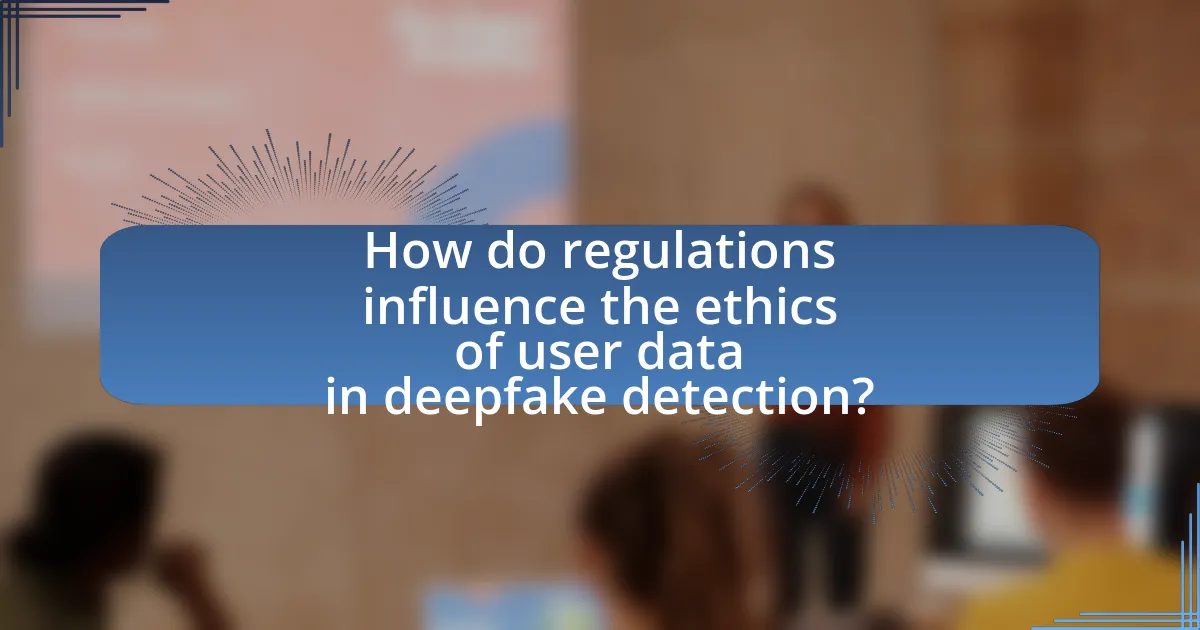
How do regulations influence the ethics of user data in deepfake detection?
Regulations significantly influence the ethics of user data in deepfake detection by establishing legal frameworks that govern data usage, consent, and privacy. These regulations, such as the General Data Protection Regulation (GDPR) in Europe, mandate that organizations obtain explicit consent from users before collecting or processing their data, thereby promoting ethical standards in data handling. Furthermore, regulations often require transparency in how user data is utilized, which helps to build trust and accountability in deepfake detection technologies. For instance, compliance with GDPR can lead to stricter data management practices, ensuring that user data is not misused or exploited, thus reinforcing ethical considerations in the development and deployment of deepfake detection systems.
What existing laws govern the use of user data in technology?
Existing laws that govern the use of user data in technology include the General Data Protection Regulation (GDPR) in the European Union, the California Consumer Privacy Act (CCPA) in the United States, and the Health Insurance Portability and Accountability Act (HIPAA) for health-related data. The GDPR mandates strict consent requirements and data protection measures for personal data, while the CCPA provides California residents with rights regarding their personal information, including the right to know and delete data. HIPAA establishes standards for the protection of health information, ensuring that personal health data is handled with confidentiality and security. These laws collectively aim to protect user privacy and regulate how organizations collect, store, and use personal data in technology.
How do these laws apply specifically to deepfake detection technologies?
Laws regarding user data protection, such as the General Data Protection Regulation (GDPR) and the California Consumer Privacy Act (CCPA), apply to deepfake detection technologies by imposing strict guidelines on how personal data is collected, processed, and stored. These regulations require that any data used for training deepfake detection algorithms must be obtained with explicit consent from users, ensuring transparency and accountability in data handling practices. For instance, GDPR mandates that individuals have the right to know how their data is used and can request its deletion, which directly impacts how companies develop and deploy deepfake detection systems. Compliance with these laws is essential for organizations to avoid significant fines and legal repercussions, as non-compliance can lead to penalties of up to 4% of annual global turnover under GDPR.
What are the challenges in enforcing these regulations?
The challenges in enforcing regulations related to the ethics of user data in deepfake detection technologies include the rapid evolution of technology, lack of standardized guidelines, and difficulties in monitoring compliance. Rapid technological advancements outpace regulatory frameworks, making it hard for authorities to keep up with new methods of data usage and manipulation. Additionally, the absence of universally accepted standards complicates the enforcement process, as different jurisdictions may interpret regulations differently. Monitoring compliance is further hindered by the decentralized nature of data and the anonymity often associated with deepfake technologies, which can obscure the identities of those violating regulations.
How do ethical frameworks guide the use of user data in deepfake detection?
Ethical frameworks guide the use of user data in deepfake detection by establishing principles that prioritize user consent, privacy, and accountability. These frameworks, such as the Fair Information Practice Principles (FIPPs), emphasize the importance of obtaining informed consent from users before collecting their data, ensuring that individuals are aware of how their information will be used. Additionally, ethical guidelines advocate for data minimization, meaning only the necessary data should be collected to achieve the detection goals, thereby protecting user privacy. Furthermore, accountability measures are outlined to ensure that organizations using this data are responsible for its ethical handling and the implications of their detection technologies. For instance, the European Union’s General Data Protection Regulation (GDPR) enforces strict rules on data usage, reinforcing the need for ethical considerations in technology deployment.
What ethical principles should be considered when using user data?
When using user data, key ethical principles include consent, privacy, transparency, and data minimization. Consent ensures that users are informed and agree to how their data will be used, which is supported by regulations like the General Data Protection Regulation (GDPR) that mandates explicit consent for data processing. Privacy involves safeguarding user information from unauthorized access and ensuring that data is stored securely, as highlighted by numerous data breaches that have compromised user data. Transparency requires organizations to clearly communicate their data practices, allowing users to understand how their data is utilized, which builds trust and accountability. Data minimization emphasizes collecting only the data necessary for a specific purpose, reducing the risk of misuse and aligning with ethical standards that prioritize user rights and autonomy.
How can organizations ensure compliance with ethical standards?
Organizations can ensure compliance with ethical standards by implementing comprehensive ethical guidelines and training programs. These guidelines should be developed based on established ethical frameworks, such as the IEEE Global Initiative on Ethics of Autonomous and Intelligent Systems, which emphasizes accountability, transparency, and fairness. Regular training sessions for employees on these ethical standards can reinforce the importance of ethical behavior in handling user data, particularly in sensitive areas like deepfake detection technologies. Additionally, organizations should conduct regular audits and assessments to evaluate adherence to these standards, ensuring that any deviations are promptly addressed. This approach not only fosters a culture of ethics but also aligns with legal requirements and public expectations regarding user data protection.
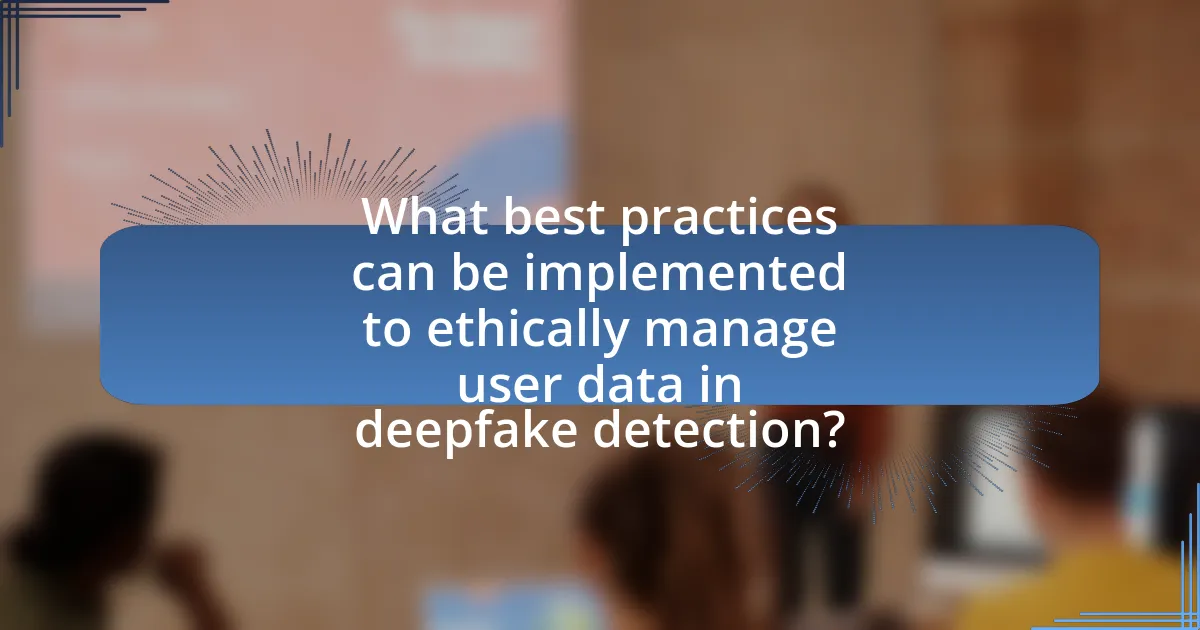
What best practices can be implemented to ethically manage user data in deepfake detection?
To ethically manage user data in deepfake detection, organizations should implement data minimization, informed consent, and robust data security measures. Data minimization involves collecting only the necessary information required for detection, thereby reducing the risk of misuse. Informed consent ensures that users are aware of how their data will be used, fostering transparency and trust. Additionally, robust data security measures, such as encryption and access controls, protect user data from unauthorized access and breaches. These practices align with ethical standards and legal requirements, such as the General Data Protection Regulation (GDPR), which emphasizes the importance of user privacy and data protection.
How can transparency be improved in user data collection processes?
Transparency in user data collection processes can be improved by implementing clear and accessible privacy policies that outline data usage, collection methods, and user rights. These policies should be written in plain language to ensure users understand how their data is being utilized. Additionally, organizations can enhance transparency by providing users with real-time notifications about data collection activities and allowing them to opt-in or opt-out of data sharing. Research indicates that 79% of consumers are concerned about how their data is being used, highlighting the need for organizations to prioritize transparency to build trust and comply with regulations like the GDPR, which mandates clear communication regarding data practices.
What role does user consent play in ethical data management?
User consent is fundamental in ethical data management as it ensures that individuals have control over their personal information. This control is essential for maintaining trust between users and organizations, particularly in sensitive areas like deepfake detection technologies, where data privacy is paramount. According to the General Data Protection Regulation (GDPR), obtaining explicit consent from users is a legal requirement for processing personal data, reinforcing the ethical obligation to respect user autonomy. Furthermore, studies show that organizations that prioritize user consent are more likely to foster positive relationships with their users, leading to increased engagement and compliance with data protection laws.
How can organizations communicate their data usage policies effectively?
Organizations can communicate their data usage policies effectively by utilizing clear, concise language and accessible formats. This approach ensures that users understand how their data will be collected, used, and protected. For instance, organizations can implement visual aids such as infographics and videos to simplify complex information, making it easier for users to grasp the key points. Additionally, providing a summary of the policy at the beginning can help users quickly identify the most critical aspects. Research indicates that 70% of users prefer visual content over text, highlighting the importance of engaging formats in communication. Furthermore, organizations should regularly update their policies and notify users of any changes, fostering transparency and trust.
What measures can be taken to protect user privacy in deepfake detection?
To protect user privacy in deepfake detection, implementing data anonymization techniques is essential. Anonymization ensures that personal identifiers are removed from datasets used for training detection algorithms, thereby safeguarding individual identities. Additionally, employing federated learning allows models to be trained on decentralized data without transferring sensitive information to a central server, further enhancing privacy. Research indicates that these methods can significantly reduce the risk of exposing user data while still enabling effective deepfake detection (source: “Federated Learning: Opportunities and Challenges,” by McMahan et al., 2017).
How can data anonymization techniques enhance user privacy?
Data anonymization techniques enhance user privacy by removing or altering personally identifiable information (PII) from datasets, making it difficult to trace data back to individual users. This process protects user identities while still allowing for data analysis and insights. For instance, techniques such as data masking, aggregation, and differential privacy ensure that sensitive information is not exposed, thereby reducing the risk of data breaches and misuse. According to a study by the National Institute of Standards and Technology, effective anonymization can significantly lower the likelihood of re-identification, thereby reinforcing user privacy in various applications, including deepfake detection technologies.
What are the benefits of implementing robust data security protocols?
Implementing robust data security protocols significantly enhances the protection of sensitive information from unauthorized access and breaches. These protocols safeguard user data, ensuring compliance with regulations such as GDPR and HIPAA, which mandate strict data protection measures. Furthermore, organizations that adopt strong data security practices can reduce the risk of financial losses associated with data breaches, which, according to IBM’s 2021 Cost of a Data Breach Report, averaged $4.24 million per incident. Additionally, robust data security fosters user trust, as individuals are more likely to engage with technologies, including deepfake detection, when they feel their data is secure. This trust is crucial for the ethical use of user data in emerging technologies.
What are the future trends in the ethics of user data for deepfake detection technologies?
Future trends in the ethics of user data for deepfake detection technologies will increasingly focus on transparency, consent, and accountability. As deepfake technologies evolve, there will be a growing demand for clear guidelines on how user data is collected, used, and shared, ensuring that individuals are informed and can provide explicit consent. Additionally, regulatory frameworks are likely to emerge, holding companies accountable for ethical data practices, as seen in the implementation of the General Data Protection Regulation (GDPR) in Europe, which emphasizes user rights and data protection. Furthermore, advancements in privacy-preserving techniques, such as federated learning, will enable deepfake detection systems to improve without compromising user data, aligning technological progress with ethical standards.
How might advancements in technology impact ethical considerations?
Advancements in technology significantly impact ethical considerations by introducing new challenges related to privacy, consent, and accountability. For instance, the development of deepfake detection technologies raises concerns about how user data is collected, stored, and utilized, often without explicit consent from individuals. Research indicates that 85% of users are unaware of how their data is used in AI systems, highlighting a gap in informed consent. Furthermore, as these technologies evolve, the potential for misuse increases, necessitating robust ethical frameworks to ensure responsible usage and protect individual rights.
What role will public opinion play in shaping future regulations?
Public opinion will significantly influence future regulations regarding deepfake detection technologies. As societal awareness of the ethical implications of user data and deepfakes increases, policymakers are likely to respond to public concerns by implementing stricter regulations. For instance, surveys indicate that a majority of the public supports regulations that protect personal data and ensure transparency in AI technologies, which can lead to legislative actions aimed at safeguarding user privacy and ethical standards in deepfake detection. This trend is evident in recent regulatory frameworks, such as the European Union’s General Data Protection Regulation (GDPR), which was shaped by public demand for greater data protection.
